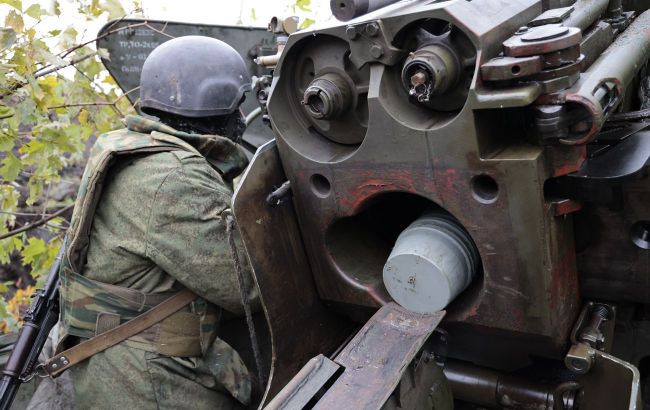Russian army seized record territory in Ukraine over the past week - Bloomberg
 Photo: Russian army seizes record territory in Ukraine over the past week (Getty Image)
Photo: Russian army seizes record territory in Ukraine over the past week (Getty Image)
The Russian army is accelerating its advance in eastern Ukraine, capturing more territory last week than at any other time this year. This intensifies pressure on American and European allies of Kyiv to bolster its defense, according to Bloomberg.
Over 200 square kilometers have been added to the territory seized during the grueling summer offensive, which has caused significant losses for Russian troops and equipment.
Based on changes tracked by the DeepState service in cooperation with the Ukrainian Ministry of Defense, Bloomberg Intelligence estimates indicate that since August 6, Russia has taken control of 1,146 square kilometers of Ukrainian territory, approximately 25% more than in the first seven months of the year.
According to Bloomberg, the Russian army has captured the largest area since the beginning of the year.

Aid to Ukraine
The outcome of the US election next week could mean that Kyiv will be forced to accept a peace deal on unfavorable terms or face the prospect of continuing to fight Russia alone, said two individuals close to the office of Ukrainian President Volodymyr Zelenskyy, who spoke on condition of anonymity. One of the sources said there is an increasing sense of despair among officials regarding the course of the war.
The Russian advance remains gradual and far from controlling all the territory in four eastern regions of Ukraine, which Vladimir Putin has illegally declared part of his country. Nevertheless, Putin is leveraging his battlefield advantage as the US is consumed by presidential election campaigns, and European allies nervously await a potential Trump victory. The Republican candidate has claimed he would quickly end the war and has expressed skepticism about continued Western support for Ukraine’s defense.
Zelenskyy informed journalists that his forces have received only 10% of the $61 billion aid package promised by the US in April, attributing delays to bureaucracy and logistics. He has repeatedly requested the US, so far unsuccessfully, to provide long-range weaponry so Ukraine can strike military targets in Russia.
Two Western officials familiar with the situation reported that NATO allies are hesitant to provide additional support to Ukraine, fearing an escalation of the confrontation with Russia. The allies see no signs that Russia is interested in negotiating a ceasefire.
Frontline situation
This comes as Ukrainian forces continue to occupy territory in Russia’s Kursk region. The sudden advance in August was partly aimed at relieving pressure in eastern Ukraine, forcing Moscow to redeploy some of its troops. So far, Russia has shown no signs of being distracted.
This week, Russian forces took control of Selydove, with Pokrovsk and Kurakhove as their next targets. Both cities are crucial logistical hubs for Ukraine’s defense in the Donetsk region. If Putin takes these cities, it will mark another milestone in his quest to seize the entire industrial eastern Ukraine.
Ukrainian forces are gradually losing ground in the Kursk region as Russia intensifies its offensive. Thousands of North Korean soldiers have arrived in the region and may soon join Russian forces on the battlefield, according to US and South Korean officials.
“Russia’s territorial gains over the past three months are likely a result of the numerical superiority of Russian forces and their dominance in artillery use due to much greater access to shells compared to Ukrainian forces. However, these local Russian successes do not indicate a turning point in a war that remains one of attrition,” said Alex Kokcharov, a geo-economic analyst at Bloomberg Economics regarding Russia and Eastern Europe.
Mobilization in Ukraine and Russia
A law that came into force in May lowered the conscription age in Ukraine from 27 to 25 years and required men to register for possible conscription. However, mobilization has caused tension among the population as Ukraine seeks to expand its army, which still lags behind Russian troops in numbers.
Secretary of the National Security and Defense Council Oleksandr Lytvynenko informed lawmakers that Ukraine plans to mobilize over 160,000 people as part of its conscription plan. More than 1 million people have already been conscripted.
Russia is also facing difficulties in sustaining its military efforts, which include redeploying waves of troops to defensive positions in Ukraine, suffering losses that the US this week estimated at 1,200 per day.
The Kremlin is reluctant to issue a new mobilization order, fearing a repeat of internal tension caused by the war that followed the call-up of 300,000 reservists in September 2022. Instead, it is relying on increasingly attractive enlistment bonuses to convince Russians to sign military contracts for combat in Ukraine.
Putin has turned to Iran for drones and to North Korea for missiles and millions of artillery shells to supply his army in Ukraine. The Russian defense industry is pressured to ramp up production in an overheated economy.
According to Ben Barry, a senior fellow for land warfare at the International Institute for Strategic Studies in London, Russia currently appears to lack the strategic resources to develop its tactical achievements on the battlefield into a decisive breakthrough in the war. “The chances of either side achieving a breakthrough are very low,” he said.
In recent weeks, creeping enemy advances have continued at several fronts — Kupiansk, Pokrovsk, Kurakhove, and Vuhledar—without decreasing pace.
For more details on the situation at the front, read RBC-Ukraine's article, "Pokrovsk, Kurakhove and new threat in the south: What's happening on the frontline."

